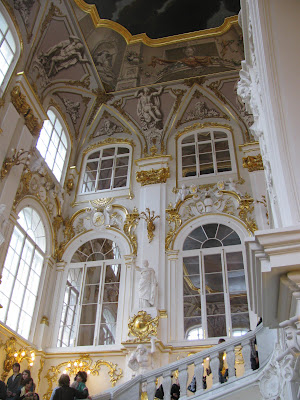The experts say that if you were to spend a minute looking at each exhibit on display in the Hermitage, you would need 11 years before you’d seen them all. However, we recommend you opt for a guided tour instead!
The view as you enter
We are lucky that photography is allowed provided you don't use a flash.
My biggest complaint would be the lack of crowd control, people are going in every direction without any order. Most museums use ropes to control the flow of the crowd but here people are going back and forth and there are a lot of tour groups as well as individual visitors.
This wasn't even high season so I can only imagine what it is like in the summer months. My biggest fear was losing our guide (not because I liked her, as I didn't, but then none of our group did). She didn't speak very loudly and she also had a supercilious attitude. But I didn't want to be lost in this museum as one of our party eventually did.
Crowds
Lucky group #6!
The Google Art Project is a great place to virtually visit some of the museum.
The Peacock clock is a work of wonder. There is a great detailed description of the Peacock clock at the hermitage's own website. It is the only large 18th-century automaton in the world to have come down to us unaltered and in a functioning condition.
The babushkas are out in hordes guarding the displays, woe to anyone who dares to touch anything, even to sitting on a radiator as some of our party found out!!
From the 1760s onwards the Winter Palace was the main residence of the Russian Tsars. Magnificently located on the bank of the Neva River, this Baroque-style palace is perhaps St. Petersburg’s most impressive attraction. Many visitors also know it as the main building of the Hermitage Museum. The green-and-white three-storey palace is a marvel of Baroque architecture and boasts 1,786 doors, 1,945 windows and 1,057 elegantly and lavishly decorated halls and rooms, many of which are open to the public.
The Winter Palace was built between 1754 and 1762 for Empress Elizabeth, the daughter of Peter the Great. Unfortunately, Elizabeth died before the palace’s completion and only Catherine the Great and her successors were able to enjoy the sumptuous interiors of Elizabeth’s home. Many of the palace’s impressive interiors have been remodeled since then, particularly after 1837, when a huge fire destroyed most of the building. Today the Winter Palace, together with four more buildings arranged side by side along the river embankment, houses the extensive collections of the Hermitage. The Hermitage Museum is the largest art gallery in Russia and is among the largest and most respected art museums in the world.
Here is an aerial view courtesy of http://www.1000lonelyplaces.com
Here is an aerial view courtesy of http://www.1000lonelyplaces.com
The museum was founded in 1764 when Catherine the Great purchased a collection of 255 paintings from the German city of Berlin. Today, the Hermitage boasts over 2.7 million exhibits and displays a diverse range of art and artifacts from all over the world and from throughout history (from Ancient Egypt to the early 20th century Europe). The Hermitage’s collections include works by Leonardo da Vinci, Michelangelo, Raphael and Titian, a unique collection of Rembrandts and Rubens, many French Impressionist works by Renoir, Cezanne, Manet, Monet and Pissarro, numerous canvasses by Van Gogh, Matisse, Gaugin and several sculptures by Rodin. The collection is both enormous and diverse and is an essential stop for all those interested in art and history.
Looking out into the Courtyard - we walked around it a few days later on our own
A cultured out group
















































No comments:
Post a Comment
This blog does not allow anonymous comments.